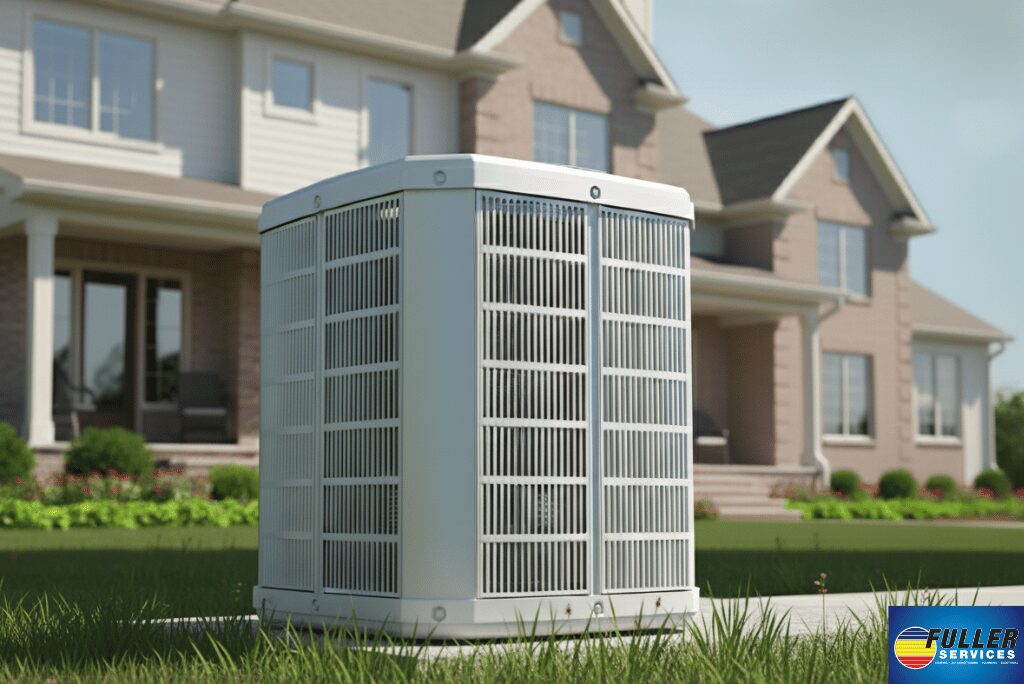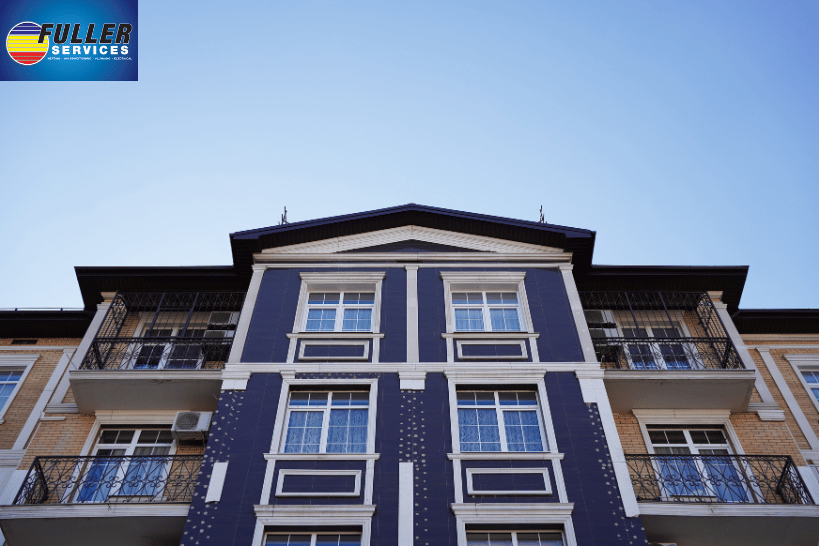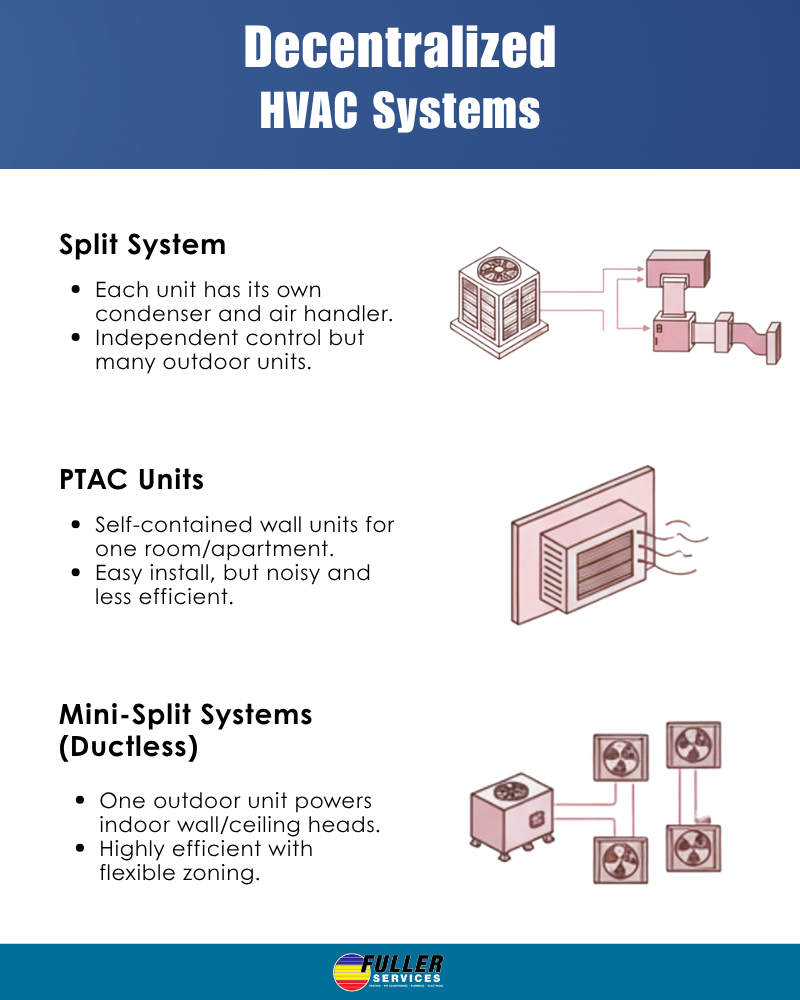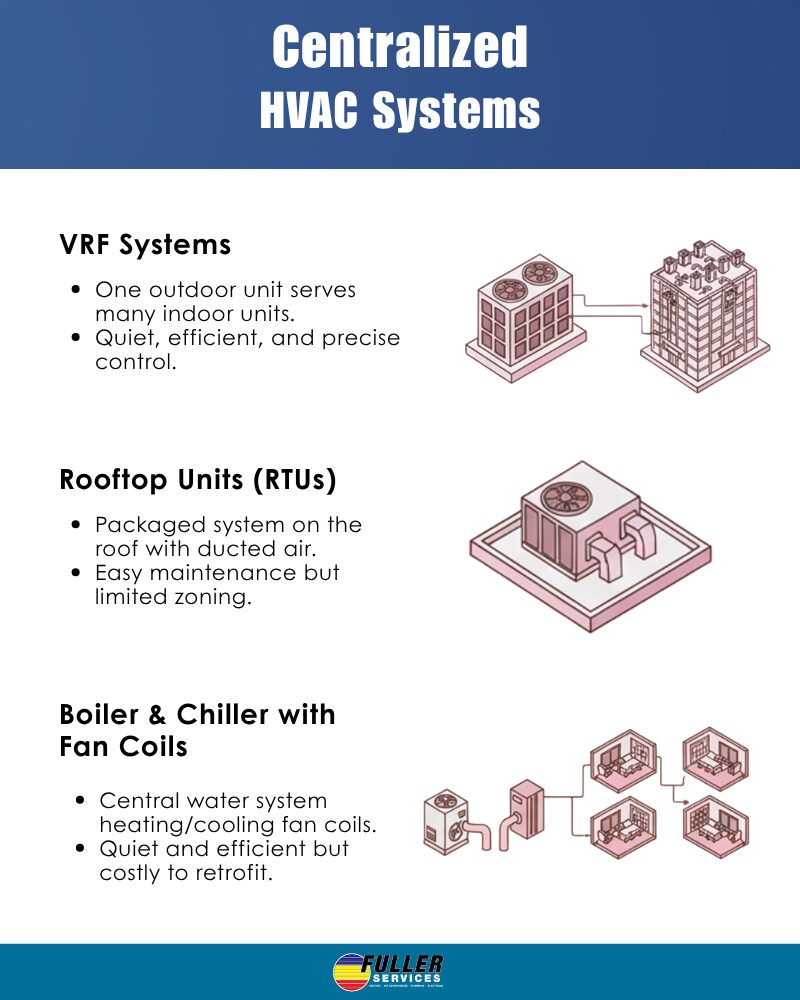
Choosing the right HVAC system for a multi-family home means balancing comfort, energy use, tenant control, and long-term maintenance. Whether you’re managing a small duplex or a mid-rise apartment building, your choice of system will influence operating costs, resident satisfaction, and even building design.
This guide walks through the different HVAC options, how they fit into centralized or decentralized categories, and what makes one system better for a particular property type.
What Is a Multi-Family Home?
A multi-family home is a building designed to house more than one household. Structures vary in size and type. A two-unit duplex converted from a single-family home is considered multi-family, as are large apartment complexes with hundreds of tenants.
Multi-family homes are typically grouped into three categories based on total units:
- Two to four units (small)
- Five to twenty units (medium)
- More than twenty units (large)
HVAC needs differ greatly between these types. A system that’s a perfect fit for a triplex will likely struggle in a mid-rise tower, and vice versa.
Centralized vs. Decentralized HVAC Systems
There are two main approaches to HVAC design in residential buildings: centralized and decentralized systems.
A centralized HVAC system uses one or more large machines, usually in a mechanical room or on the roof, to serve the entire building. These are common in larger multi-family properties. While efficient at scale, centralized systems typically limit tenant control and make utility billing more complicated.
In a decentralized system, each apartment unit has its own heating and cooling equipment. That gives residents individual control, simplifies billing, and is usually easier to install during light renovations or smaller builds. But decentralized systems require multiple points of maintenance and sometimes sacrifice efficiency when scaled across large buildings.
Both approaches have advantages. The best fit depends on building size, design, and how much control you want to give to residents.

Should Tenants Control Their Own HVAC?
One of the bigger questions in multi-family HVAC planning is how much control each tenant should have. It really depends on the size of the building, your preferred management style, and what kind of experience you want to offer tenants.
Individual control can lead to higher tenant satisfaction. When residents can adjust the temperature in their own unit, they’re more likely to feel comfortable and stay longer. It also lets them manage their own energy use, which can reduce complaints and disputes over heating or cooling.
On the other hand, centralized systems take control out of the tenant’s hands. That can simplify operations in larger buildings, where maintaining and monitoring dozens of separate systems isn’t practical. It can also keep heating and cooling costs more predictable, which is helpful if utilities are included in the rent.
Billing plays a role, too. Decentralized systems make it easy to assign energy costs directly to tenants. Centralized systems require shared billing arrangements or sub-metering, both of which come with added setup and tracking.
In small and mid-sized properties, resident control offers more benefits than drawbacks. In larger buildings, central control may be the only workable option. Either way, it’s worth thinking about control early, since it will shape how your HVAC system is designed from the start.
HVAC System Options for Multi-Family Properties
Below are the most common types of HVAC systems used in multi-family housing projects.

Decentralized
Split Systems
A split system is a common HVAC setup where each unit has its own outdoor condenser and indoor air handler. Ductwork connects the components and moves air throughout each living space.
This system is reliable and easy to install in small or medium-sized buildings. Since each unit operates independently, tenants can manage their own temperature and utility usage. However, fallbacks include the need for multiple outdoor units and periodic maintenance in each apartment.
Split systems are best suited to properties with two to ten units, especially when each needs its own utility metering.
PTAC Units
Packaged terminal air conditioners, or PTACs, are self-contained units installed through an exterior wall. They both heat and cool and are most often seen in hotels and older low-rise apartments.
Each unit manages a single room or apartment. Tenants get direct control, and you don’t need to install ductwork. These are quick to install and easy to swap out when needed, making them a popular retrofit choice.
On the downside, PTACs are noisy and not as energy-efficient as other options. They also take up indoor wall space and aren’t always visually appealing.
Mini-Split Systems (Ductless)
A mini-split—or ductless system—uses one outdoor compressor to power one or more indoor heads. These heads are mounted on walls or ceilings and allow for individual temperature control by zone or room.
These units are among the most efficient and flexible systems available for small to medium-sized buildings. They’re perfect for buildings without ductwork and offer some of the highest energy performance ratings available.
Like split systems, mini-splits require multiple outdoor units or a more complex line routing plan in larger buildings. They also involve higher installation costs up front, but long-term savings are often significant.

Centralized Systems
VRF Systems
A variable refrigerant flow (VRF) system is a more advanced version of the mini-split concept. One or more outdoor units serve many indoor units across the building, with the refrigerant flow adjusted dynamically based on demand.
VRFs are ideal for large, modern buildings. They allow precise temperature control per unit or even per room, without sacrificing centralized efficiency. While expensive to install and requiring trained technicians, VRFs are efficient, quiet, and scalable.
This system is a strong choice for 20+ unit buildings where both energy efficiency and individual tenant control are important.
Rooftop Units–RTUs
Rooftop packaged units combine heating and cooling into one system located on the building’s roof. These systems force air through ducts to all units in the building and are typically used in low- to mid-rise properties.
RTUs reduce indoor equipment clutter and allow easy access for maintenance. But without duct zoning or dampers, they limit individual temperature control in each unit. They’re also better suited for buildings with flat roofs and moderate climates.
This system works best in mid-sized buildings when simplicity of installation and centralized maintenance are higher priorities than individual zoning.
Boiler and Chiller with Fan Coils
These systems use a central boiler to heat water and a chiller to cool it. That water then runs to fan coil units in each apartment, where the air is heated or cooled before being circulated.
Often found in older high-rise apartments, these systems are quiet and efficient in dense buildings where ducting is impractical. Control varies depending on fan coil configuration; some systems provide individual thermostats, while others operate off centralized programming.
Boiler/chiller systems require significant infrastructure and are costly to retrofit, but may remain viable for existing large buildings due to their centralized and compact water-based design.
Looking at the Options Side by Side
Below, you’ll see a quick comparison of the aforementioned HVAC systems.
| System Type | Centralized | Best For | Tenant Control | Efficiency | Installation Cost | Notes |
|---|---|---|---|---|---|---|
| Split Systems | No | 2–10 unit buildings | Full | Medium-High | Medium | Requires space for outdoor units |
| PTAC Units | No | Small units or retrofits | Full | Low-Medium | Low | Noisy, visible inside room |
| Mini-Split Systems | No | Small or mid-sized buildings | Full | High | Medium-High | Efficient; some units require multiple heads |
| VRF Systems | Yes | Large buildings (20+ units) | Zoned | Very High | High | Needs expert install and design |
| Rooftop Units | Yes | Mid-size, flat-roof buildings | Limited | Medium | Medium | Centralized maintenance |
| Boiler/Chiller + Fan Coils | Yes | Large or old high-rise units | Limited | Medium-High | High | Good option in existing large buildings |
What to Keep in Mind Before You Decide
There’s no universal solution when it comes to HVAC for multi-family homes. The right system depends on your building’s size, layout, and intended use. Small buildings benefit from tenant-controlled systems like mini-splits or split systems, while larger buildings achieve better efficiency and control with centralized solutions like VRF or rooftop units.
Take the time to evaluate how much control tenants should have, what your building structure allows, and your long-term goals for energy and maintenance. Choosing the right system early can lower costs and reduce headaches for years to come.
If you’re planning a new project or considering an upgrade, Fuller HVAC can walk you through your options. Our team helps property owners choose systems that make sense—not just today, but long-term. Contact Fuller HVAC for a consultation tailored to your building.
